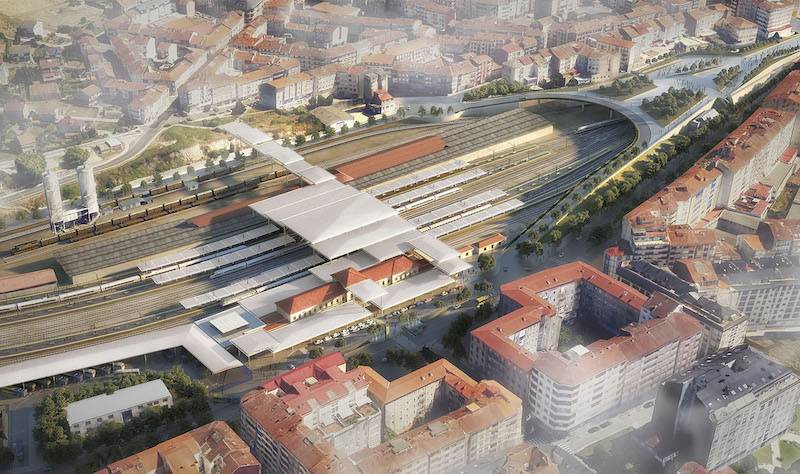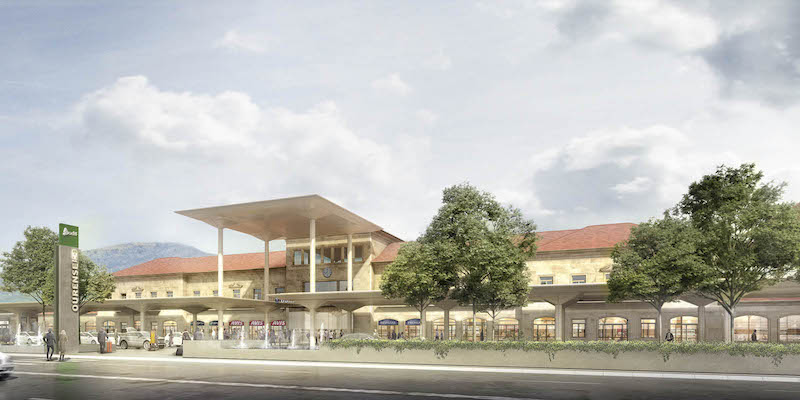Foster + Partners’ plan for the Ourense FFCC Station in Galicia, Spain is to bring together high-speed rail and bus stations in a major urban intervention. This will open pedestrian links between the districts on either side of the tracks and create a new public plaza for the city.
The existing railway line is being upgraded to accommodate high-speed rail links in the region, something the recently revealed design takes into consideration. The plans call for a new station that caters to the increased passenger numbers created by the high-speed rail and creates a framework for a new transport interchange. Included in the new terminal will be a direct connection with the adjacent bus terminal, a new urban square in front of the station, and a pedestrian walkway and public park over the tracks.
 Rendering courtesy of Foster + Partners.
Rendering courtesy of Foster + Partners.
The addition will be made from concrete plates and slender columns that match the color of the existing station’s granite. The new concrete plates will provide shelter from rain and high temperatures common to the area’s summers. The roofs are designed as a modular system requiring minimal maintenance with the capability of accommodating future expansions.
A new portico highlights the entry canopy and will feature cafés and shops. The front of the station will spill directly onto a new urban square. Meanwhile, the internal lobby will be reconfigured to create a space filled with natural light and triple-height ceilings. Historic frescoes on the upper portions of the walls are being retained and restored.
 Rendering courtesy of Foster + Partners.
Rendering courtesy of Foster + Partners.
Wayfinding through the station has been improved via clear visual connections from the check-in stations to the trains. Additionally, a direct internal connection to the bus station creates an easy link to the city and surrounding area.
Related Stories
| May 13, 2014
19 industry groups team to promote resilient planning and building materials
The industry associations, with more than 700,000 members generating almost $1 trillion in GDP, have issued a joint statement on resilience, pushing design and building solutions for disaster mitigation.
| May 11, 2014
Final call for entries: 2014 Giants 300 survey
BD+C's 2014 Giants 300 survey forms are due Wednesday, May 21. Survey results will be published in our July 2014 issue. The annual Giants 300 Report ranks the top AEC firms in commercial construction, by revenue.
| May 1, 2014
Super BIM: 7 award-winning BIM/VDC-driven projects
Thom Mayne's Perot Museum of Nature and Science and Anaheim's new intermodal center are among the 2014 AIA TAP BIM Award winners.
| Apr 29, 2014
USGBC launches real-time green building data dashboard
The online data visualization resource highlights green building data for each state and Washington, D.C.
Smart Buildings | Apr 28, 2014
Cities Alive: Arup report examines latest trends in urban green spaces
From vertical farming to glowing trees (yes, glowing trees), Arup engineers imagine the future of green infrastructure in cities across the world.
| Apr 9, 2014
Steel decks: 11 tips for their proper use | BD+C
Building Teams have been using steel decks with proven success for 75 years. Building Design+Construction consulted with technical experts from the Steel Deck Institute and the deck manufacturing industry for their advice on how best to use steel decking.
| Apr 2, 2014
8 tips for avoiding thermal bridges in window applications
Aligning thermal breaks and applying air barriers are among the top design and installation tricks recommended by building enclosure experts.
| Mar 26, 2014
Free transit for everyone! Then again, maybe not
An interesting experiment is taking place in Tallinn, the capital of Estonia, where, for the last year or so, its 430,000 residents have been able to ride the city’s transit lines practically for free. City officials hope to pump up ridership by 20%, cut carbon emissions, and give low-income Tallinnites greater access to job opportunities. But is it working?
| Mar 26, 2014
Callison launches sustainable design tool with 84 proven strategies
Hybrid ventilation, nighttime cooling, and fuel cell technology are among the dozens of sustainable design techniques profiled by Callison on its new website, Matrix.Callison.com.
| Mar 20, 2014
Common EIFS failures, and how to prevent them
Poor workmanship, impact damage, building movement, and incompatible or unsound substrate are among the major culprits of EIFS problems.

















